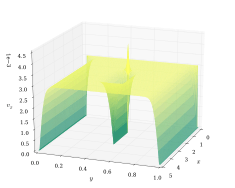Method of undetermined coefficients
| Differential equations | |||||
|---|---|---|---|---|---|
 Navier–Stokes differential equations used to simulate airflow around an obstruction. | |||||
| Classification | |||||
|
Types
|
|||||
|
Relation to processes |
|||||
| Solution | |||||
|
General topics |
|||||
In mathematics, the method of undetermined coefficients is an approach to finding a particular solution to certain inhomogeneous ordinary differential equations and recurrence relations. It is closely related to the annihilator method, but instead of using a particular kind of differential operator (the annihilator) in order to find the best possible form of the particular solution, a "guess" is made as to the appropriate form, which is then tested by differentiating the resulting equation. For complex equations, the annihilator method or variation of parameters is less time consuming to perform.
Undetermined coefficients is not as general a method as variation of parameters, since it only works for differential equations that follow certain forms.[1]
Description of the method
Consider a linear non-homogeneous ordinary differential equation of the form
- ... where denotes the i-th derivate of y, and denotes a function of x
The method consists of finding the general homogeneous solution for the complementary linear homogeneous differential equation
and a particular integral of the linear non-homogeneous ordinary differential equation based on . Then the general solution to the linear non-homogeneous ordinary differential equation would be
If consists of the sum of two functions and we say that is the solution based on and the solution based on . Then, using a superposition principle, we can say that the particular integral is
Typical forms of the particular integral
In order to find the particular integral, we need to 'guess' its form, with some coefficients left as variables to be solved for. This takes the form of the first derivative of complementary function. Below is a table of some typical functions and the solution to guess for them.
| Function of x | Form for y |
|---|---|
|
| |
|
| |
|
| |
|
| |
|
|
If a term in the above particular integral for y appears in the homogeneous solution, it is necessary to multiply by a sufficiently large power of x in order to make the solution independent. If the function of x is a sum of terms in the above table, the particular integral can be guessed using a sum of the corresponding terms for y.[1]
Examples
- Example 1
Find a particular integral of the equation
The right side t cos t has the form
with n = 1, α = 0, and β = 1.
Since α + iβ = i is a simple root of the characteristic equation
we should try a particular integral of the form
Substituting yp into the differential equation, we have the identity
Comparing both sides, we have
which has the solution , , , . We then have a particular integral
- Example 2
Consider the following linear nonhomogeneous differential equation:
This is like the first example above, except that the nonhomogeneous part () is not linearly independent to the general solution of the homogeneous part (); as a result, we have to multiply our guess by a sufficiently large power of x to make it linearly independent.
Here our guess becomes:
By substituting this function and its derivative into the differential equation, one can solve for A:
So, the general solution to this differential equation is thus:
- Example 3
Find the general solution of the equation:
f(t), , is a polynomial of degree 2, so we look for a solution using the same form,
- , where
Plugging this particular integral with constants A, B, and C into the original equation yields,
- , where
- and and
Replacing resulting constants,
To solve for the general solution,
where is the homogeneous solution , therefore, the general solution is:
References
- 1 2 Ralph P. Grimaldi (2000). "Nonhomogeneous Recurrence Relations". Section 3.3.3 of Handbook of Discrete and Combinatorial Mathematics. Kenneth H. Rosen, ed. CRC Press. ISBN 0-8493-0149-1.
- 1 2 Dennis G. Zill (2001). A first course in differential equations - The classic 5th edition. Brooks/Cole. ISBN 0-534-37388-7.
- Boyce, W. E.; DiPrima, R. C. (1986). Elementary Differential Equations and Boundary Value Problems (4th ed.). John Wiley & Sons. ISBN 0-471-83824-1.
- Riley, K. F.; Bence, S. J. (2010). Mathematical Methods for Physics and Engineering. Cambridge University Press. ISBN 978-0-521-86153-3.
- Tenenbaum, Morris; Pollard, Harry (1985). Ordinary Differential Equations. Dover. ISBN 978-0-486-64940-5.
- de Oliveira, O. R. B. (2013). "A formula substituting the undetermined coefficients and the annihilator methods". Int. J. Math. Educ. Sci. Technol. 44 (3): 462–468. doi:10.1080/0020739X.2012.714496.